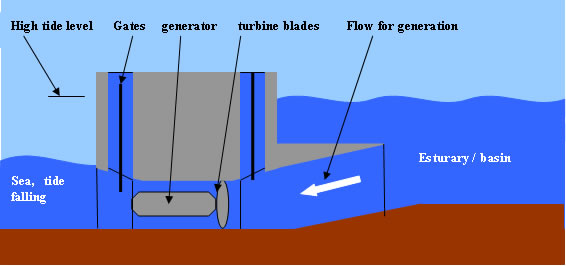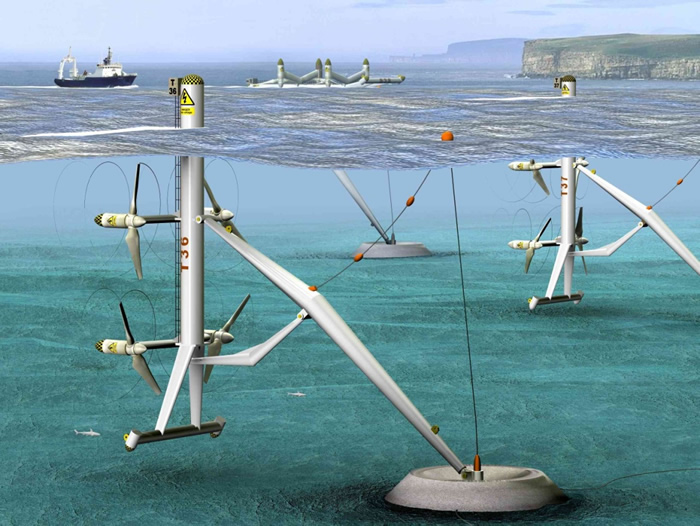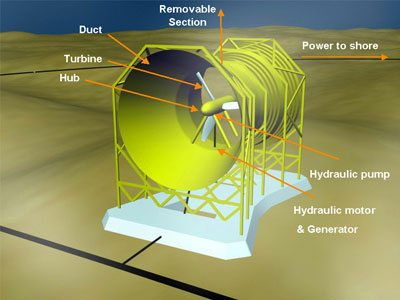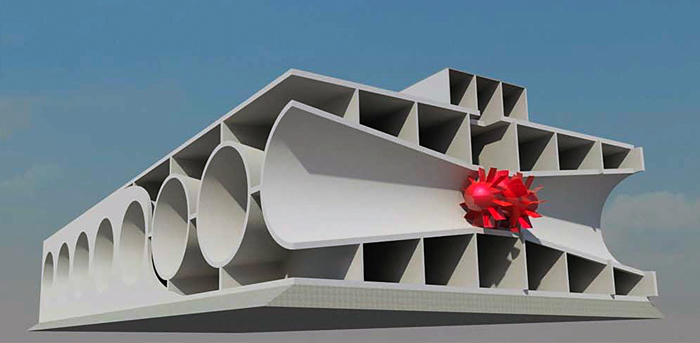People are becoming aware of the importance of ocean energy, which will lead to a new era of alternative energy. Because of this knowledge, tidal energy has great potential and bright prospects in future.
Len Calderone for | AltEnergyMag
Gravity plays an important role in our lives. It keeps our feet on the ground and the planets in order. Gravity is very noticeable on our planet, specifically, it is responsible for the rise and fall of the ocean’s tides worldwide.
To understand how the tides work it’s important to understand the relationship between the motion of our planet and its moon. The Moon's gravitational forces are strong enough to cause the oceans to bulge, which causes a high tide. Because of the rotation of the Earth a high tide also occurs on the other side of the planet. As the moon moves around the Earth, the bulge (high tide) moves with it. The moon’s movement creates the waves that are part of the tidal energy.
Tides are more predictable than wind energy and solar power. The main problem with tidal power is its comparatively high cost and limited accessibility of locations that have suitably high tidal ranges or flow velocities.
Tidal energy is one of the oldest forms of energy dating back to the seventh century. The tides turned waterwheels, producing power in order to mill grain, similar to what is used in streams.
The emission of gases responsible for global warming and acid rain is eliminated by the use of tidal energy.
The Rotech tidal turbine has been designed to be uncomplicated and tough, keeping costs and maintenance down. With the turbine unit attached to the seabed, the rotor blades are designed to work in either tide direction so that the whole unit does not need to be rotated, or the pitch of the blades changed when the tide turns.
The Venturi effect is the reduction in fluid pressure that results when a fluid flows through a constricted section of pipe. A Venturi shaped duct is used to channel and increase the speed of the tidal stream toward the rotor. By using a Venturi duct, more energy can be extracted from the same amount of water with smaller diameter rotor blades. This design is suitable for slow tide movement, and a wide angle diffuser will help if the turbine axis is not aligned with the tidal flow, as turbine assemblies are bi-directional or multidirectional.
A tidal barrage uses the energy of the water, captured at high tide behind a dam in an estuary. Water flows to the lower level as the tide recedes, driving turbines which in turn drive electric generators. The system could work both ways. A typical tidal power barrage may look like this:

A barrage is similar to a hydroelectric dam, and is essentially a large concrete structure that spans an estuary basin, bay or river with sluices that enable waves to move in and out of the dammed area. At high tide, the sluices are closed; but when the tide shifts directions and ebbs, the sluices are opened allowing the higher water levels in the basin to flow through the barrage and pass the hydroelectric turbine on its way out to sea. The basin is refilled when the tide flows back to shore.
Another form of tidal energy is dynamic tidal power that requires the construction of a long dam perpendicular to the coast that could be over 15 miles long, since the structure has to be long enough to influence tidal patterns and cause high and low tides to occur simultaneously on opposite sides of the structure.
Below is a cut-away of a dam caisson showing a turbine that generates electricity with the flow of water between one side of the dam and the other.
Dynamic tidal power does not require the enclosure of a basin, which reduces its environmental impact. This long caisson would interfere with the coastal parallel tidal wave hydrodynamics, creating water level differences on opposite sides of the barrier which drive a series of bi-directional turbines, which are installed in the caisson. Oscillating tidal waves which run along the coasts of the continental shelves contain powerful hydraulic currents.
It is estimated that some of the largest dams could accommodate over 15 GW (15000 MW) of installed capacity. If the average American household consumes 12,000 KWh per year, one dynamic tidal power dam could supply energy for about 1.5 million households.

A marine current turbine looks like a smaller version of a land windmill and the principle is precisely the same. But whereas a windmill draws energy from the movement of air, the marine turbine uses currents in the water. A single 30 foot long rotor blade will be able to produce 300 kilowatts of electricity.
Since the ocean currents are more reliable than wind, marine turbines are a rival to wind power. They are also less obtrusive, since the structure is built on the seabed and projects just a few feet above the surface. Fish can feel safe because the blades rotate slowly at only 20 revolutions per minute.
The wave snake is a device that is a big red cylindrical tube that is 426.5 feet long, 13 feet in diameter, weighing around 750 tons. The snake has a life expectancy of up to 20 years, with tubes that are connected by hinges so that they float like a snake in the water. The snake rises up and down as the passing waves tug on the hinges, which are resisted by hydraulic rams, which pump high-pressure fluid through hydraulic motors and turn electrical generators to produce electricity. The energy, which comes from the joints on each wave-energy conversion, is fed via a cable to a central undersea export cable, which carries the combined power generated from a nest of snakes to shore.

Ocean thermal energy conversion (OTEC) refers to technologies that utilize the temperature differential between the upper and lower layers of the ocean to drive a heat engine. In geographical areas with warm surface water and cold deep water, the temperature difference of at least 38 degrees Fahrenheit can be leveraged to drive a steam cycle that turns a turbine and produces power. Warm surface sea water passes through a heat exchanger, vaporizing a low boiling point working fluid to drive a turbine generator, producing electricity. These power plants use the difference in temperature to make energy.

The water on the ocean’s surface is used to heat a pressurized liquid, usually ammonia, which boils at a temperature slightly below that of warm seawater. That liquid becomes gas, which powers a turbine generator. Cold water is then pumped from the ocean’s depths through a long submerged pipe in order to condense the gas back into a liquid, and the cycle is repeated.
The best ocean thermal resources are located in tropical and subtropical deep waters. Ocean thermal energy systems have three cost fundamentals, which are the platform, the cold water pipe, and the heat exchangers. Prefabricated cold water pipes made from inexpensive, lightweight composite materials, have the potential to appreciably lower the cost of OTEC technology, along with new platform construction techniques.
With the increasing demand for energy, the traditional fossil energy sources, such as coal, oil, natural gas, will eventually be depleted. Plus these same fossil fuels lead to many environmental issues. People are becoming aware of the importance of ocean energy, which will lead to a new era of alternative energy. Because of this knowledge, tidal energy has great potential and bright prospects in future.
For further information:
2. http://www.eolss.net/Sample-Chapters/C08/E3-08-05-07.pdf
3. http://www.oceanrenewable.com/wp-content/uploads/2007/03/futuremarineenergy.pdf
4. http://www.exergy.se/goran/hig/re/08/ocean.pdf
5. http://www.inference.phy.cam.ac.uk/sustainable/refs/WaveTidal.pdf
The content & opinions in this article are the author’s and do not necessarily represent the views of AltEnergyMag
Comments (0)
This post does not have any comments. Be the first to leave a comment below.
Featured Product





